How did the Revolutionary War impact the West?
George Rogers Clark was an American general in the Revolutionary War whose military successes against American Indians and the British in the Ohio River Valley are credited as a major factor in treaty negotiations that established the original boundaries of the United States.
By a treaty between the French and British that ended the French and Indian War in 1763, the British agreed to prohibit American settlers from crossing the Allegheny Mountains to settle in the Ohio River Valley. It had little impact on settlers, however, as colonists began arriving to stake claims to live there or hold them as speculators.
George Rogers Clark
Born in 1752, George Rogers Clark was the second of 10 children, including his younger brother William, who was a leader of the Lewis and Clark expedition to explore the Missouri River in 1804. In his late teens, George learned surveying from his grandfather. At age 20, Clark led a survey expedition into Kentucky, relocated his family there and became a local leader as a guide for fellow Virginia arrivals.
American Indians who lived in the region resented and resisted the intrusion into their hunting lands. Frontier conflicts occurred when Shawnee, Mingo and Delaware tribes pushed back against growing numbers of settlers. Governor Dunsmore of Virginia raised a force against the Shawnee and drove them into central Ohio.
When the American Revolution began in 1776, Clark secured a commission from Virginia to raise an army and march against British forts and their American Indian allies. He routed the British from several small forts and earned a reputation as a successful American Indian fighter. The British launched a counter campaign later in the war and temporarily reclaimed some outposts, but Clark countered with an offensive that captured the British commander. Clark also continued to engage American Indians in battle and drive them westward in combat in order to make the territory safe for American settlers.
Clark's Impact on the West
His successes established an American military presence in the region. When the Treaty of Paris in 1783 officially ended the Revolution, the United States successfully claimed the territory from the Alleghenies to the Mississippi River in part pointing to Clark’s successful "occupation." American Indians were never included in those treaty discussions. In recognition of his military achievements, Clark was named as a principal surveyor of the region and was consulted on American Indian affairs, because he had shown an ability to fight and kill American Indians and colonize their land.
Supporting Questions
How did the war in the West influence the outcome of the Revolution?
- Letter from Thomas Jefferson to George Washington about George Rogers Clark and the Illinois Expedition, June 17, 1779 (Document)
- Treaty of Paris, 1783 (Document)
- Boundaries of the United States according to the 1783 Treaty of Paris, 1784 (Map)
- Excerpt from Benjamin Franklin's Memoir about Peace Negotiations, 1818-1819 (Document)
What leadership skills did military leaders like George Rogers Clark exhibit during the Revolutionary War that led to military and diplomatic successes?
- Letter from Patrick Henry to Virginia Delegates in Congress, November 14, 1778 (Document)
- Letter from George Rogers Clark to Patrick Henry, April 29, 1779 (Document)
- Letter from George Rogers Clark to George Mason, November 19, 1779 (Document)
- Part I: "Some Account of the Achievements of the Celebrated Virginian Hero, George Rogers Clark, in the Western Country," March 30, 1816 (Document)
- Part II: "Some Account of the Achievements of the Celebrated Virginian Hero, George Rogers Clark, in the Western Country," March 30, 1816 (Document)
How is the success of Americans in the West during the Revolution related to the acquisition of land?
- British and French Dominions of North America, 1763 (Map)
- United States of America, 1783 (Map)
- Louisiana Purchase, 1805 (Map)
- Settled Part of Wisconsin Territory, 1838 (Map)
| American Revolutionary War and Its Impact on the West Teaching Guide |
| Printable Image and Document Guide |
Letter from Thomas Jefferson to George Washington about George Rogers Clark and the Illinois Expedition, June 17, 1779
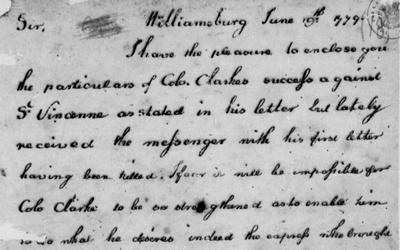
Description
Thomas Jefferson, who was Virginia’s governor at the time, wrote this letter to George Washington in June of 1779. General Washington was Commander in Chief of the United State Army and received reports of military activity from around the entire country. Jefferson’s…
Treaty of Paris, 1783
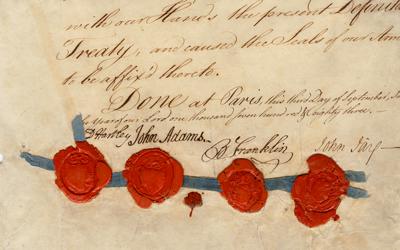
Download Resource Download Resource
Description
The Treaty of Paris was negotiated to end the American Revolution. John Adams, Ben Franklin and John Jay were the American representatives. Their discussions regarding the boundaries of the United States resulted in the western border of the United States being set at the…
Boundaries of the United States according to the 1783 Treaty of Paris, 1784
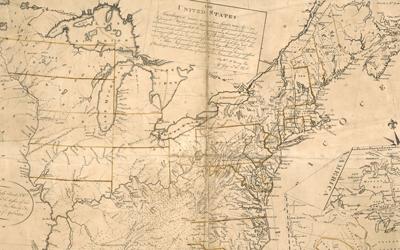
Description
This 1784 map shows the boundaries of the United States after the American Revolutionary War. Negotiations to end the war included debates about how far west the western border of the United States would be. According to the Treaty of Paris,…
Excerpt from Benjamin Franklin's Memoir about Peace Negotiations, 1818-1819
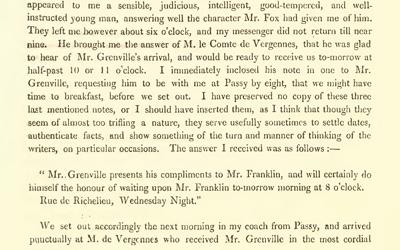
Download Resource Download Resource
Description
Benjamin Franklin was one of the representatives the United States sent to Paris to negotiate a treaty of peace between the United States and Great Britain in order to end the Revolutionary War. Franklin kept private journals, as well as…
Letter from Patrick Henry to Virginia Delegates in Congress, November 14, 1778
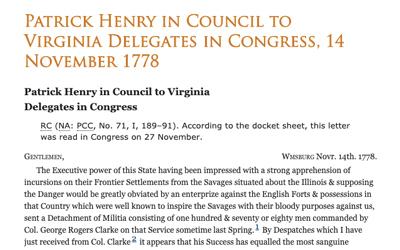
Description
In January 1778, Virginia Governor Patrick Henry, acting with the advice of the Council of State and the authorization of the General Assembly, directed Lieutenant Colonel George Rogers Clark to raise a force of 350 men to capture Kaskaskia and other British posts in the…
Letter from George Rogers Clark to Patrick Henry, April 29, 1779
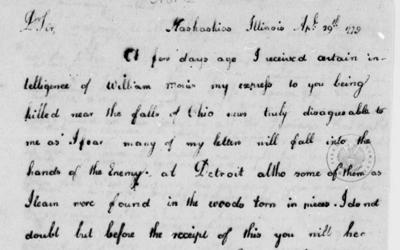
Download Resource Download Resource
Description
George Rogers Clark wrote this letter to Governor Patrick Henry to report that he had taken the fort at Vincennes on the Wabash River from the British under the command of Henry Hamilton. Clark and his soldiers arrived at Vincennes after enduring a 200-mile march from…
Letter from George Rogers Clark to George Mason, November 19, 1779
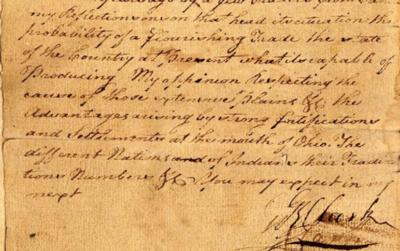
Description
George Rogers Clark wrote this letter to his friend, George Mason. In the letter, Clark describes his recollections of his campaign fighting in Illinois. Clark gives detailed accounts of his dealings with British Governor Hamilton and his brutality toward American Indians…
Part I: "Some Account of the Achievements of the Celebrated Virginian Hero, George Rogers Clark, in the Western Country," March 30, 1816
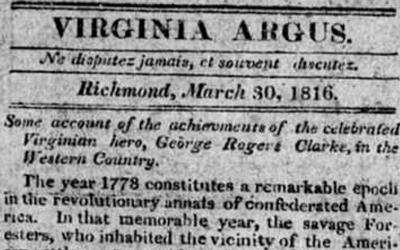
Description
The Virginia Argus printed the story of George Rogers Clark and his Revolutionary War "achievements" in 1816 in two parts. Part I tells the story of Clark taking the British fort at Kaskaskia, as well as several other towns on the Mississippi River. The author…
Part II: "Some Account of the Achievements of the Celebrated Virginian Hero, George Rogers Clark, in the Western Country," March 30, 1816
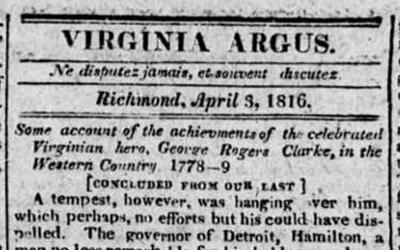
Description
This article is the second part of the story of George Rogers Clark in the Revolutionary War. It tells of the journey made by Clark and the men under his command from Kaskaskia near St. Louis to Vincennes on the Wabash River.
British and French Dominions of North America, 1763
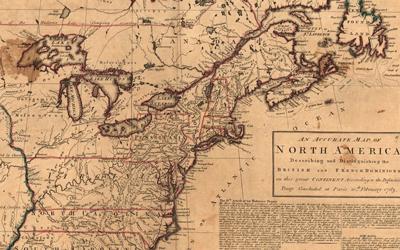
Description
The 1763 map defines the borders between French and British land claims at the end of the French and Indian War (Seven Years War). It shows British land claims extending to the Mississippi River and the French in control of Louisiana, to the west of the Mississippi. It also…
United States of America, 1783
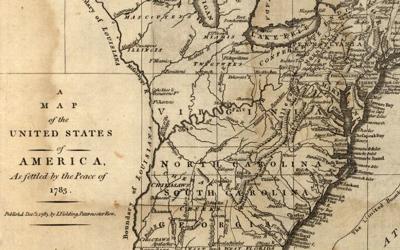
Description
This 1783 map shows the boundaries of the United States as settled by the Treaty of Paris after the Revolutionary War. The map distinctly shows the territory of Louisiana to the west of the United States, separated from the United States by the Mississippi River. One of the…
Louisiana Purchase, 1805

Description
This 1805 map shows the Louisiana Territory. On the map, the forts of Kaskaskia and Cahokia can be seen on the east side of the Mississippi River. George Rogers Clark led Americans to capture both forts during the Revolutionary War, leaving the United States in possession of…
Settled Part of Wisconsin Territory, 1838
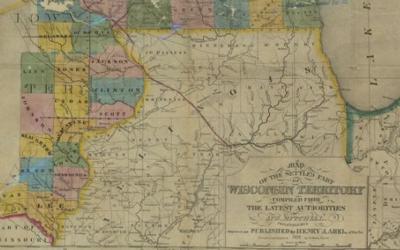
Description
This 1838 map shows the territory labeled Wisconsin. The map shows the Wisconsin Territory existing on both sides of the Mississippi River, including territory that had been part of the Louisiana Purchase and would become the State of Iowa
Additional Resources
- George Rogers Clark: "I Glory in War" by William R. Nester
This 2012 biography tells the story of George Rogers Clark (1752–1818), who led four victorious campaigns in the Ohio Valley during the American Revolution. Author William R. Nester resurrects the story of Clark's triumphs and failures. - George Rogers Clark and the War in the West by Lowell H. Harrison
This biography about George Rogers Clark focuses on how he was one of the few people who saw the importance of the West as part of the American Revolutionary War effort as a whole, and he persuaded Virginia's government to lend support to his efforts. - "The Old Northwest Under British Control, 1763-1783" and "Indiana A Part of the Old Northwest, 1783-1800" by George W. Geib
These chapters are featured in the 1987 book, "Indiana: A Handbook for U. S. History Teachers," which encourages more effective state citizenship through the teaching of state history. Attention is given to geographical factors, politics, government, social and economic changes and cultural development. - "General Clark — Hannibal of the West" by L.M. Grimes
This 1949 article from The Annals of Iowa focuses on the military feats of George Rogers Clark during the American Revolutionary War.
Iowa Core Social Studies Standards (8th Grade)
Listed below are the Iowa Core Social Studies content anchor standards that are best reflected in this source set. The content standards applied to this set are elementary-age level and encompass the key disciplines that make up social studies for eighth-grade students.
| No. | Standard Description |
| SS.8.18. | Explain how the physical and human characteristics of places and regions influence culture. |
| SS.8.20. | Explain how global interconnections influenced early American history. |
| SS.8.21. | Analyze connections among early American historical events and developments in broader historical contexts. |
| SS.8.23. | Explain multiple causes and effects of events and developments in early American history. |